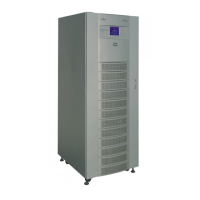34 User Manual 10H52192UM60 - Rev. 1 - 09/2011
Liebert NX Operation
4.1.2 Static Transfer Switch
The circuit block labeled STS in Figure 4-1 contains an electronically controlled switching circuit that enables the load to be
connected to either the inverter output or to the bypass power source via the static bypass line. During normal system operation,
the load is connected to the inverter; but in the event of a UPS overload or inverter fault, the load is automatically transferred to the
static bypass line.
During normal operating conditions, the inverter output and bypass supply must be fully synchronized in order to guarantee clean
(no-break) load transfer between the inverter output and static bypass line. The synchronization between the inverter output and
static bypass is achieved through the inverter control electronics, which make the inverter frequency track that of the static bypass
supply, provided that the bypass remains within an acceptable frequency window.
A manually-controlled maintenance bypass supply is incorporated into the UPS design. It enables the critical load to be powered
from the maintenance bypass supply while the UPS is shut down for routine maintenance and repair.
Note
When the UPS is operating in bypass mode or in maintenance bypass, the equipment connected to it is not protected from power
failures, surges, or sags.
4.2 1 + N Parallel System
Up to four UPS modules can be connected in parallel to form a 1 + N system in order to increase the system capacity, reliability, or
both. The load is shared equally between the parallel UPS.
4.2.1 Parallel System Features
1. The parallel system hardware and software are identical to the single UPS module. The parallel configuration is achieved by using
settings in the configuration software. The parameter settings of each UPS module in the parallel system should be the same.
2. Parallel control cables are connected in a ring, providing both system reliability and redundancy. Dual bus control cables are
connected between any two UPS modules of each bus. The intelligent parallel logic provides the user with maximum flexibility. For
example, shutting down or starting up UPS modules in a parallel system can be done in any sequence. Transfers between normal
and bypass modes of operation are synchronized and self-recoverable, for example, after clearing any overloads that may occur.
3. The total load of the parallel system can be queried from the LCD for each UPS module.
4.2.2 Requirements for Paralleling UPS Modules
A group of paralleled modules behaves as if it were one large UPS, with the advantage of increased reliability. To ensure that all
modules are utilized equally and to comply with relevant wiring rules, the following requirements apply:
1. All UPS modules must be of the same rating and must be connected to the same bypass source.
2. The bypass and main input sources must be referenced to the same neutral potential.
3. Any RCD that is installed must be configured appropriately and located upstream of the common neutral bonding point.
Alternatively, the device must monitor the protective earth current of the system. Refer to Safety Manual.
4. The outputs of all UPS modules must be connected to a common output bus.
Note
Optional isolation transformers are available for applications where sources do not share the same neutral reference or where the
neutral is not available.
4.3 Operating Mode
The UPS is an on-line, double-conversion, reverse-transfer UPS that features the following operating modes:
Normal mode
Battery mode
Automatic restart mode
Bypass mode
Maintenance mode (manual bypass)
Parallel redundancy mode

